#historical japanese sewing
Note
I feel like I send u lots of asks at every-orochimaru, but I also really love your orokabu art, especially the "are you dead? sometimes I think I'm dead" piece!! thank you for the food, it's definitely fueled me spiraling into madness
Ah, thank you, thank you! That piece was inspired by Cavetown - This Is Home! I can also tell I had been watching Heian era inspired films because of the way I drew their hair (carbon dating my own art lol)
I've taken a break from art lately cause work is kicking my ass but I have some pieces in the works! I'm thinking about doing some historical fashion studies via Naruto characters cause it's a field that really interests me. What better way to motivate oneself to learn than to shamelessly involve the hyper-interest? :]
#peepaw posting#i wanna rewatch the tale of genji#plot so fucked but she's soooo pretty guys#but yea fashion so cool!#i love watching historical fashion youtube like omg#but a lot of them are focused on victorian/european fashions#which is fine there's plenty to learn!#and i'm sure i'm just not looking hard enough for more variety#but historical east asian fashion is extremely interesting to me for a number of reasons#i was teaching myself how to sew japanese clothing for cosplay#and i researched korean and chinese dress for stories i was working on#historical fashion is such a mess to research especially when you don't know the language#but it's really rewarding!#i always go yippee!!! when i find a new piece to my puzzle
2 notes
·
View notes
Text

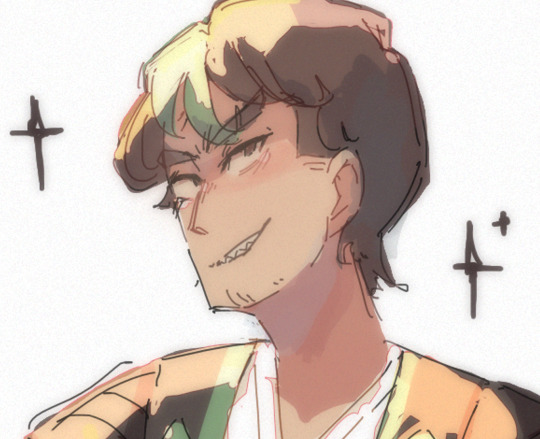
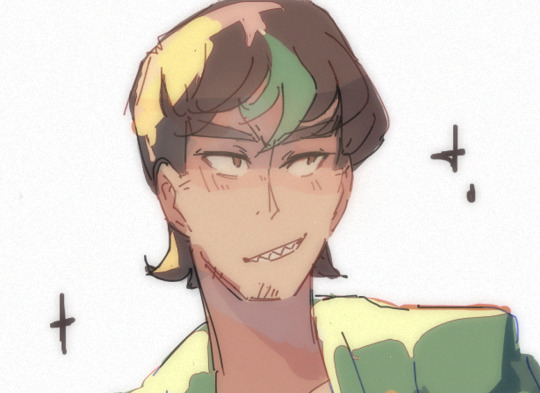
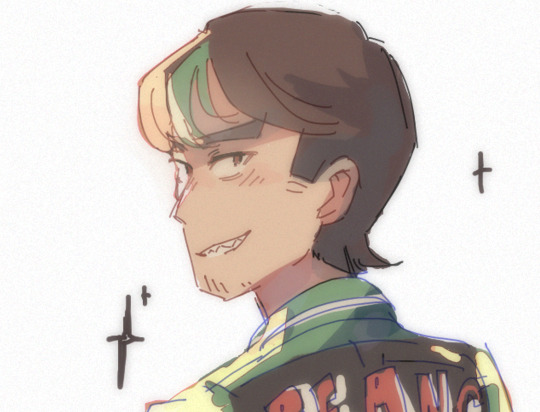
some hc10 joels at @shaklyart's request ✌️
thoughts below
while i am way too into historical costuming with little to no actual knowledge in the field i must say japanese clothing specifically is not my forte (i've always thought other ppl had that field covered) so please forgive any huge glaring inaccuracies i may present here. i am just someone simply nitpicky abt this sort of thing who doesn't actually know what im talking about.
that being said, first fit is a kamishimo + hakama + kimono, fit isn't entirely accurate but i suppose that could be blamed on him being a tourist.
second is a haori over a more casual fit that i felt like he would actually wear. very much going for that meiji-inspired modern fashion type of thing.
third is a souvenir jacket and was my first idea for a japanese joel fit considering its history and aesthetic made the most sense to me but i was afraid it wouldn't scream japan hard enough. i imagine he sewed the patches on himself.
543 notes
·
View notes
Text
Patterning a 16th c. Irish léine sleeve

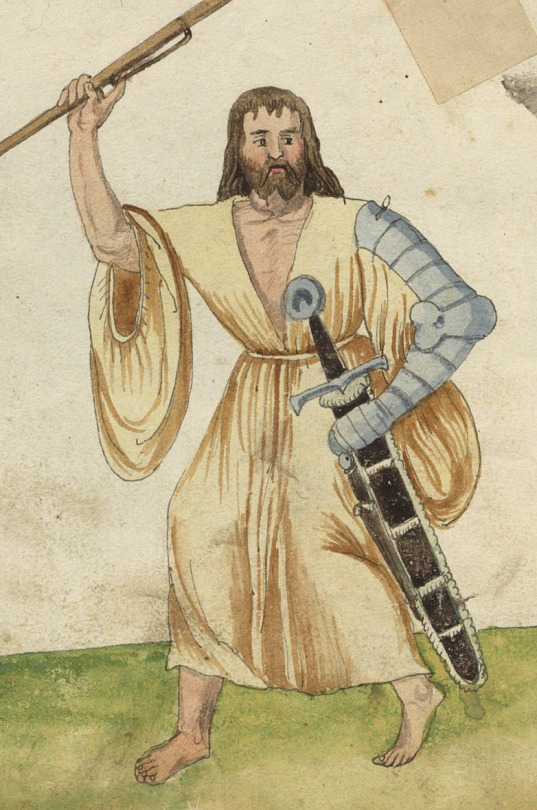
Mid-16th c. images of the léine from "Drawn after the Quick" and Codice de Trajes
The léine of 16th century Ireland had huge, iconic sleeves. Sadly, we have neither surviving examples of this garment, nor detailed period documentation, so we don't know how these sleeves were made. I have seen a couple different sewing patterns purposed, but none of these match the voluminous, gathered sleeves shown in the Codice de Trajes and the costume album of Christoph von Sternsee. This is my attempt to create a sleeve pattern that better matches the surviving evidence.
The cut of léine sleeves probably varied across 16th c. Ireland, potentially impacted by factors like a person's wealth or where in Ireland they lived. It almost certainly changed over time as more of Ireland fell to English colonial conquest. The wearing of the large-sleeved léine was banned by King Henry VIII (McClintock 1943). Lucas de Heere’s circa 1575 illustrations show women with much smaller sleeves than earlier images. However, at least during the early part of the century, sleeves did not vary by gender. According to Laurent Vital, the only difference between a man's léine and a woman's léine was that the woman's had gores in the bottom it make it fuller (Vital 1518).
My goal with this project is to create a léine sleeve pattern for an early to mid-16th c. Irish person living outside of the Pale. Since none of the period images or texts are very detailed, I am combining information from several sources.
Englishman Edmund Campion who visited Ireland in 1569 gave the following derisive description of the léine: “Linnen shirts the rich doe weare for wantonnes and bravery, with wide hanging sleeves playted, thirtie yards are little enough for one of them” (Campion 1571).
Campion’s claim that the sleeves were pleated initially struck me as strange. English and continental European shirts from this period frequently had gathered sleeves (Mikhaila and Malcolm-Davies 2006, Arnold, Tiramani and Levey 2008), but pleating isn’t the same thing as gathering. However, other period writers made similar claims. Writing in 1596, Edmund Spenser mentioned "thicke foulded lynnen shirtes” as a garment worn by the Irish (Spencer 1633).
Similarly, Fynes Moryson described the léine as being made of “thirty or forty ells [of linen] in a shirt all gathered and wrinkled,” elsewhere he described it as “folded in wrinckles” (Moryson 1617).
In The Image of Irelande, John Derricke gave the following description of the léine:
Their shirtes be verie straunge,/ not reachyng paste the thie:/ With pleates on pleates thei pleated are,/ as thicke as pleates maie lye./ Whose sleves hang trailing doune/ almoste unto the Shoe (Derricke 1581)
Assuming that Derricke’s description is not just poetic license, I know of one 16th century construction method that matches the description “pleats on pleats [. . .] as thick as pleats may lie,” and that is cartridge pleating. Cartridge pleating is a technique that is more commonly used on thick fabrics like woolens, because a lot of fabric bulk is needed to keep the pleats standing properly, but extant 16th and early 17th c. neck ruffs use cartridge pleating to join massive lengths of fine linen to a neck band (Arnold, Tiramani and Levey 2008).

Cartridge pleating on a thick woolen fabric
A person unfamiliar with sewing methods and terms might well describe cartridge pleating as looking like folds, gathers, or wrinkles.
The léine sleeve patterns commonly used in modern reconstructions are completely flat, like a Japanese kimono sleeve with rounded corners. (There’s also a version which has a drawstring or gathering running along the top of the sleeve. This is a 20th c. Ren Fair invention which has no historical basis.)
The end-on views of the sleeve openings in the recently-discovered images from Codice de Trajes and the costume album of Christoph von Sternsee clearly show that this is not correct. The rounded shape they show for the sleeve end can only be achieved through gathering.


Archer from the von Sternsee costume album and the O’Brien messenger from The Image of Irelande
The best illustration of a léine in The Image of Irelande, the messenger on plate 7, also provides evidence for a gathered sleeve. The way the fabric drapes in the middle of the sleeve suggests that the sleeve is gathered at both ends. Furthermore, the way the mass of a léine sleeve centers under the wearer’s arm when the wearer holds their arm out straight, like the O’Brien messenger, but hangs down like a trumpet when the wearer lowers their arm, like on von Sternsee’s archer also suggests that the sleeve is a symmetrical shape that is gathered at both ends and not a trumpet shape that is only gathered at the wrist end.
With these elements in mind, I went looking for a pattern which would create the correct shape. I used Jean Hunnisett's 15th c. bagpipe sleeve pattern from Period Costume for Stage and Screen and the sleeve pattern from this 1630s English waistcoat (published in Seventeenth-Century Women’s Dress Patterns) as a starting point.

1630s waistcoat sleeve pattern
I replaced the curved sleeve heads in these patterns with the straight sleeve end and square underarm gusset typical of mid-16th-18th c. shirts, since the léine, like the shirt, is an unfitted linen garment, and because the straight edge is much easier to gather all the way around. I don't have any actual evidence for square gussets in 16th c. Ireland, but this pattern definitely needs an ungathered piece at the underarm. Anyone who is bothered by the lack of evidence can use a triangular gusset like the one on the 15th c. Moy gown instead.
After that, I experimented with mock-ups until I figured out how to get the correct proportions. I don't have any training in patterning or draping, so this took several tries. I used my 1/3 scale ball-jointed doll (24 inches tall) as model, because he required a lot less fabric and sewing. Since this was just a mock-up, I used random linen remnants from my stash, and I didn't bother to finish most of the edges.
Here is the final sleeve with the seams sewn together, but before doing the gathering:

This sleeve, on his right arm, is based on the gathered-wrist cuff version of the léine from Codice de Trajes, the von Sternsee album, and The Image of Irelande.
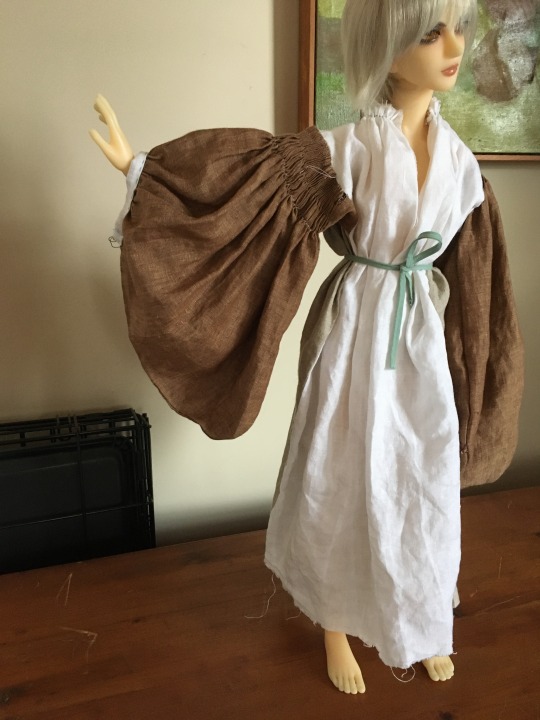


This sleeve ended up with me having to gather 31 inches of fabric into a 5-inch armscye. So yeah, cartridge pleating became necessary, because there is no way to make that kind of reduction work with regular gathering. I also had to do some smocking to get the giant mass of fabric better controlled before I could attach it to the body of the léine.
While this pattern might seem absurd, (it does call for a sleeve end wider than the wear is tall to be pleated into the armscye,) a close examination of John Michael Wright's 1680 portrait of Sir Neil O'Neill shows remarkably similar sleeves.

While this painting is from a century later than my target time period and the clothing clearly shows changes like the addition of English-style shirt sleeve ruffles, the shirt still has elements which I have seen no where else in late 17th c. fashion that are probably derived from earlier Irish dress.
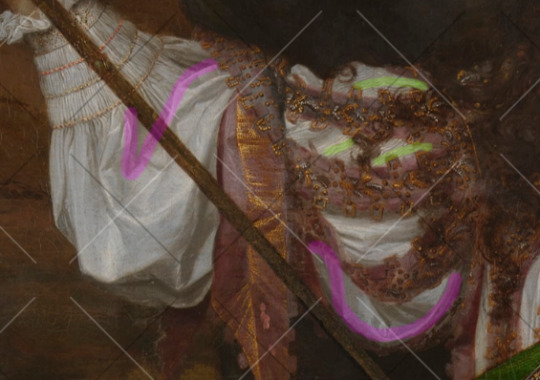
The doublet worn over top prevents it from hanging down properly, but this shirt sleeve has the same bagpipe shape as the 16th c. léine. I have highlighted it in magenta to make this easier to see. The fine, regular folds near the top of the sleeve (highlighted in yellow) are probably the result of smocking or cartridge pleating, indicating that this sleeve, like my purposed pattern, has a large amount of fabric gathered or pleated to the armscye. The wrist end of the sleeve has 3 rows of smocking stitches sewn with silk thread, which shows that the sleeve cuff has a huge amount of fabric gathered into it.
Historically, silk was the thread of choice for smocking, because it is smoother and has greater tensile strength than wool, linen, or cotton. Several 16th c. sources note that the Irish used silk thread when making their léinte (Gresh 2021). Laurent Vital described Irish women as wearing, "chemises with wide sleeves, worked around the collar and in the seams with silk needlework of different colours" (1518). The presence of smocking on O'Neill's shirt combined with my experience trying to recreate this sleeve makes me think that at least some of that 16th c. silk needlework was smocking.
For the left sleeve of my mock-up, I tried to recreate the flatter sleeves from "Drawn After the Quicke". These sleeves do not have a gathered wristband.

This sleeve used basically the same pattern, but the lack of gathering at the wrist opening meant that the whole sleeve was slightly smaller, so I only had to pleat 26 in of fabric into the armscye instead of 31 in. This was just enough of a difference that I could set the sleeve without smocking it first, unlike the right sleeve. I guess this is the more budget-friendly option for your less wealthy kern.

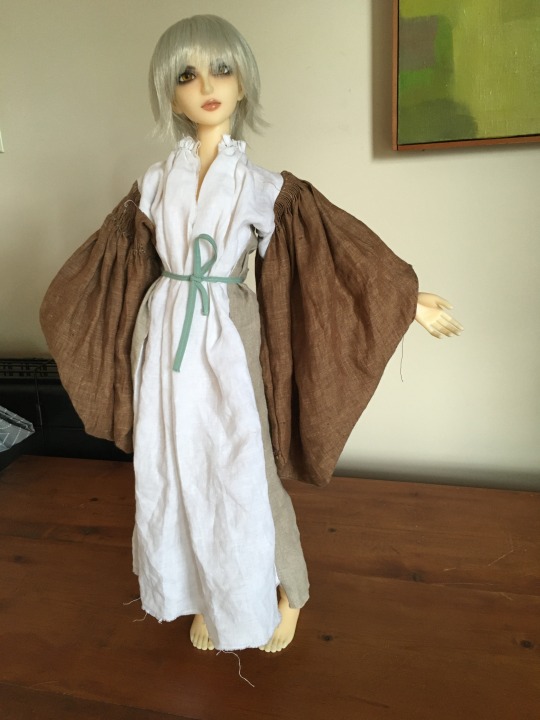
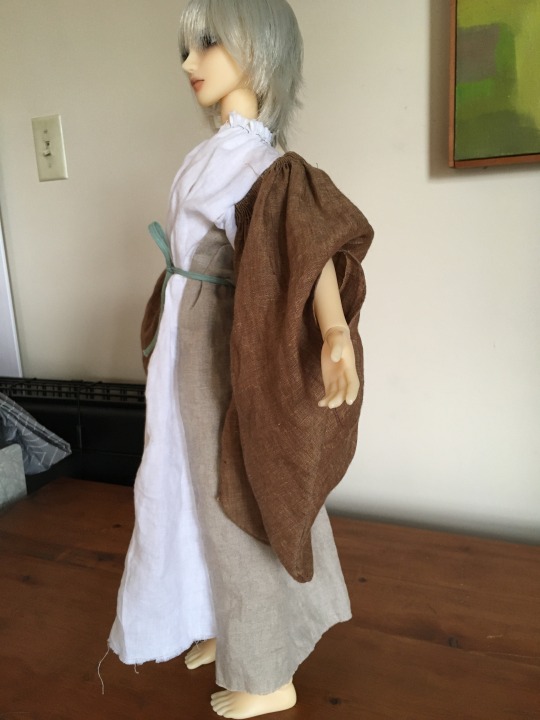
I also made the curve at the bottom of the sleeve wider to give this one a more square shape.
Some of my failed experiments:
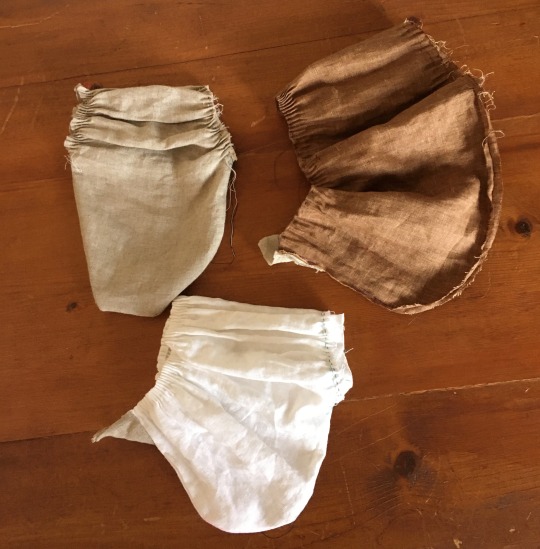
I would like to thank my friend Nikki for loaning me her smocking machine. This project would have been a much bigger pain if I had to do all those gathering stitches by hand.
Since this post has gotten rather long, I am putting the actual drafting instruction for this sleeve pattern in a separate post.
If anyone would like to support my work financially, I now have a ko-fi page.
Bibliography:
Arnold, Janet, Tiramani, J., & Levey, S. (2008). Patterns of Fashion 4. Macmillan, London.
Campion, Edmund. (1571). A Historie of Ireland, Written in the Yeare 1571. Dublin. https://archive.org/details/historieofirelan00campuoft/historieofirelan00campuoft/page/n5/mode/2up
Derricke, John. (1581). The Image of Irelande, with the discoverie of a Woodkarne. John Daie, London. https://archive.org/details/imageofirelandew00derr/page/n29/mode/2up?view=theater
Hunnisett, Jean. (1996). Period Costume for Stage & Screen: Patterns for Women's Dress, Medieval-1500. Players Press, Inc, Studio City.
Gresh, Robert. (2021). The Saffron Shirt, Part 1: Saffron and Silk, Urine and Grease. Wilde Irish. https://www.wildeirishe.com/post/the-saffron-shirt-part-1-saffron-and-silk-urine-and-grease
McClintock, H. F. (1943). Old Irish and Highland Dress. Dundalgan Press, Dundalk.
McGann, K. (2008). The Invention of Drawstrings and Pleated Sleeves. Reconstructing History. https://reconstructinghistory.com/blogs/irish/the-invention-of-drawstrings-and-pleated-sleeves-1
Mikhaila, Ninya, & Malcolm-Davies, Jane (2006). The Tudor Tailor. Quite Specific Media Group, Ltd, London.
Moryson, Fynes. (1617). An Itinerary Containing His Ten Yeeres Travell through the Twelve Dominions of Germany, Bohmerland, Sweitzerland, Netherland, Denmarke, Poland, Italy, Turky, France, England, Scotland & Ireland. volume 4. https://ia801307.us.archive.org/16/items/fynesmorysons04moryuoft/fynesmorysons04moryuoft.pdf
North, Susan and Jenny Tiramani, eds. (2011). Seventeenth-Century Women’s Dress Patterns, vol.1, V&A Publishing, London.
Spencer, Edmund. (1633). A View of the present State of Ireland. https://celt.ucc.ie/published/E500000-001/index.html
Vital, Laurent (1518). Archduke Ferdinand's visit to Kinsale in Ireland, an extract from Le Premier Voyage de Charles-Quint en Espagne, de 1517 à 1518. translated by Dorothy Convery. https://irish-dress-history.tumblr.com/post/721163132699131904/laurent-vitals-1518-description-of-ireland
#16th century#irish dress#dress history#leine#art#gaelic ireland#irish history#historical men's fashion#historical dress#historical women's fashion#sewing
25 notes
·
View notes
Text
Some Things We Know Canonically About Nikolai

He can sew (since he sewed that skin shirt).
His Japanese is proficient enough for him to be able to pass as a Japanese secretary for six months, meaning that his grammar, tones, reading, writing, typing, and mannerisms are all native-level.
He can not only connect space with his Ability, but fuse one object into another if his Ability's output space is connected to a solid object (Atsushi's leg into concrete as the example).
He knew Fyodor before Fyodor was as proficient in Japanese as he is now (since Fyodor is still learning Japanese in the omake).
He knew Fyodor at least semi-well before the plot of Sunday Tragedy (both his recollection to Sigma and various omakes confirm this).
He isn't very familiar with the concept of a band (says, "It's like an orchestra, right?" when Sigma mentions a band in an omake).
He feels guilt and remorse when he kills people (according to himself).
He knew about Atsushi's Ability before they met (called Atsushi "Tiger Boy" when they first met, said that the rumours about his were true, and might have stabbed him knowing about Atsushi's regenerative ability).
He knew about Dazai's Ability too (and tested whether he could bring Dazai through a portal anyway).
He doesn't seem interested in killing people who aren't "targets", or at least, that's his reason he gives to Atsushi for why he kept him alive. I don't think he kills indiscriminately.
Nikolai envies people who are in the cage but can't see it, possibly meaning that he wishes he didn't see it at all, and that he's only trying to escape because he can't help but know it's there (meaning he doesn't think he chooses to see the world this way).
Nikolai is drawn to, or at least thinks very highly of, people who help others and do the right thing, even at the expense of themselves (based on what he says to the ADA right before he's sawed in half).
He can perform some sort of auto-blood-transfusion-thing, or "loop the blood back into [someone's] body" (he did it with Sigma).
Dazai can fall through one of Nikolai's space connection portal things, meaning that the connected spaces in each of the rooms themselves somehow aren't being touched by his Ability (or at least, the visible connected spaces outside of his cape are only connected to his Ability via the portal walls, so the space connection process must happen within his Ability's space, and not in the "real world"). This also has to imply that either Nikolai can move an object through two connected spaces without having the object touch his cape, or that his cape isn't actually connected to his Ability (though second option seems very unlikely, the portal Dazai falls through is connected to the ceiling of the room that Nikolai is in, which he can't touch, so he really may be able to connect space without it strictly being through his cape, as opposed to what was implied in every instance before).




His right eye seems to turn pitch black when he's overtly lying/putting on an act, and looks more 'clear' when he's being more truthful.
Some Things That Could be Interpreted
He may have helped Fyodor with Japanese at some point (based on how you interpret his Japanese pun omake moments).
He may be only partially/mostly used to modern society, depending on how you interpret his historically-inspired attire and not knowing what a band is.
He doesn't derive any pleasure at all from killing or hurting people (not outright stated but implied, from what I can tell from his expressions, the "enjoyment" in such activities seems entirely feigned).
He might not be interested in maiming people who aren't targets, since he probably knew about Atsushi's regenerative ability beforehand, though that might not be the case. It depends on whether or not shooting Tonan was part of a plan, I think.
He might not be interested in playing certain characters outside of their roles. For example, for Atsushi, who isn't a target but is part of the ADA, he drops the clown persona for a moment. He does it again for Tonan right before he releases him. Though there isn't much to go on, it could be interpreted here that he doesn't play acts for people said acts aren't originally meant for.
He might see people who are "in the cage" similar to actors on a sort of improv stage. If you think of his secretary act as being who he needed to be to have Tonan cooperate (and thanking Tonan twice for pretty much acting exactly as planned), then it could be similar to him thinking that Akaky Akakievich's superiors interacted with him exactly as they should, or if not as they should morally, then add they should societally, which ultimately trumps morality. All of this, Nikolai would think of as detached from himself, yet as he's still in the cage physically, and not yet even out (can only see the bars where others can't), he could watch and muse at all these goings on, and when it comes to him having to interact with those almost scripted personalities, he might script a personality for himself, working within the play that people unintentionally mould themselves into, being the exact sort of person that they need to interact with in order for them to make his desired result happen. (In action, this would be him being the meek, simpleminded, pitiful secretary, who seems only to exist in order to be briefly bullied and ordered by his superior, the Minister of Justice. And Tonan would have every right to treat the Secretary this way, would even be expected to, and it's such a normal scene that neither Tonan nor anyone else would think anything of it, they'd simply gaze over their interactions as though they were part of the wallpaper, and it would give Nikolai plenty of leeway to do whatever he needed to do in the government. It's also present in how he talks about being the sort of person the people he's killed needing to see, for them to think of him as a psychopath in order to find peace, so he played a psychopath for them {Tonan actually fits this description of needing it, too, and if you read it back, I think that exact interaction Nikolai described to Atsushi was happening when Nikolai untied Tonan}.

And yet he breaks the act, which doesn't fit his script at all, and you can see the moment it all slips from an orchestrated play into reality, if only for a moment.
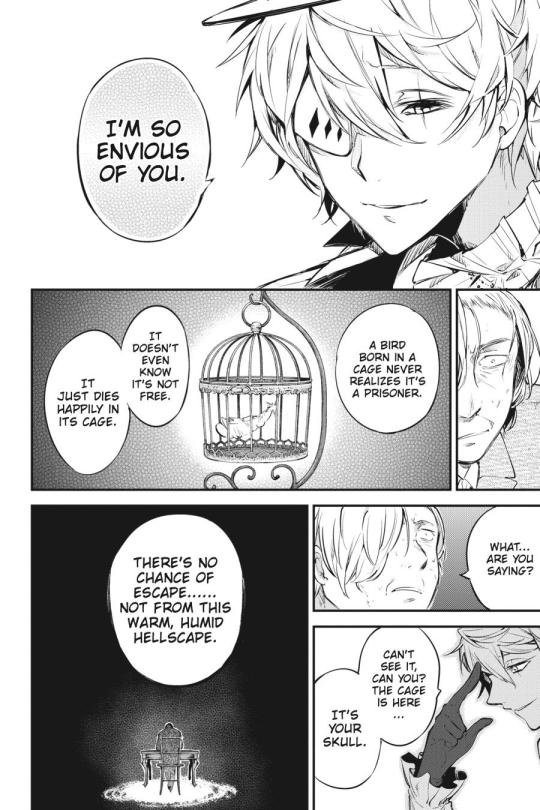
Though I suppose there's also some irony here, that when Nikolai's breaking his personal script, he's saying lines scripted for him in the Book.)
Considering the way he thanks Tonan for his help, although somewhat mocking, I think enough in his expression when he's talking about the birdcage at Tonan to imply that he doesn't take how Tonan treated his Secretary persona personally (in his "I envy you" speech).
The particular way he always positions/moves his hands could be indicative of something, but of what seems completely open to interpretation.
Considering what he knew about Atsushi and Dazai's Abilities, he may know all of the ADA's Abilities.
#Oct. 2022#BSD#BSD Nikolai#BSD Gogol#BSD Nikolai Gogol#bsd gogol nikolai#bsd gogol theory#BSD Gogol analysis#BSD analysis#bsd nikolai theory#bsd nikolai hcs#BSD Nikolai analysis#might add more later#this is just a quick thing i wanted to post to get my thoughts together#and maybe help someone too
278 notes
·
View notes
Text
another one! tagged by @scarvenartist (thanks!! hello! :D)
Are you named after anyone? Yes! BibleCharacter from ABibleBook :}
When was the last time you cried? Monday when I watched the 2nd half of Hamilton. I've cried so much in the past two weeks?? three whole times?? I never cry this much?? but Hamilton made me cry twice and learning Japanese made me cry once
Do you have kids? Nope. Unless you count my favorite ocs, in which I have... *counts*... at least twenty.
What sports do you play/have you played? I was in one semester of hap ki do once! That was fun. I also like to walk. I did twice-weekly long walks as all my P.E. credits in homeschool, and to this day I always walk rather than take busses. I'm dreading having to find ways to exercise other than my in-built College Campus Walks To Classes when I leave college :((( maybe I'll start yoga again... sigh... or maybe I'll do what sparks joy and go hike by myself sometimes! I'm hoping to take more martial arts classes in the future, too.
Do you use sarcasm? Sometimes! but only in situations where I'm pretty confident it'll be well received and isn't mean-spirited. although I admit in my worst/most fearful moments with strangers sometimes I do get sarcastic as a defense mechanism. I'm growing out of that, though.
What is the first thing you notice about people? Nowadays it's fashion choices, usually. I like noticing what people choose to wear! I love it when people get weird with it. Old ladies with big ostentatious earrings are some of my favorites to see. Also young adults with anime stuff on their backpacks.
What's your eye color? Brown :} rich warm dark brown
Scary movies or happy endings? Happy ending most of the time Please 🥺 I only like watching scary/sad stuff with my dad. he unlocks that in me. and sometimes with Stormy.
Any talents? good at clay sculptures! also good at coming up with fun characters and plots, and making people laugh. also academic writing and helping people with academic writing!
Where were you born? I was grown in a tube, next question
What are your hobbies? writing, reading, watching anime, posting on tumblr dot com, seeking out and stealing poems for my personal poetry document, ceramics, sewing (exclusively plushie mice)
Do you have any pets? Not right now, but I used to have hamsters and I want to have hamsters (or Maybe a related form of rodent e.g. guinea pigs or rats) again. I will after college probably!
How tall are you? 5'4. a good height
Favorite subject in school? Currently, Advanced Ceramics is my favorite class. Historically, English, Psychology, and History have been my favorites overall.
Dream job? tbh, interlibrary loan assistant..... I dream of having @isfjmel-phleg's career..... but currently I'm pursuing professional tutoring bc it seems more achievable
Tagging... anyone who wants to do this! I feel like my friends are all pretty busy right now so I'll leave it up to whoever sees this and Likes these questions :}
10 notes
·
View notes
Text
Saguaro Outfit Analysis
Wow, I’m so pleasantly surprised at the positive reception to the 1950s analysis I made for Saguaro! I’ll be referencing parts of that post a lot in this outfit analysis, because I think the historical references in Saguaro’s clothes are really important.
Usual disclaimer: I am not an expert on fashion, this is an analysis based on my own knowledge, research, and passion on the subject. If there are any corrections or additions you’d like to make, please let me know! ^_^
Saguaro is depicted to be a “fashionable and cool” man- and he is! He balances out the colors in his outfit very well, it’s clear he cares a lot about his appearance. I mentioned in the 1950s post that Saguaro has an almost outdated style, but he twists it to be contemporary and trendy.
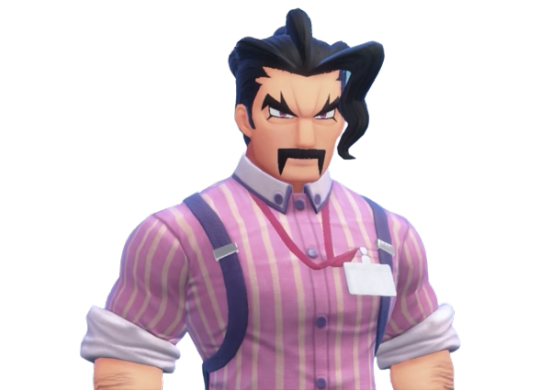
His blouse looks reminiscent of a chef’s uniform due to the buttons and white collar/sleeves, as the uniform is traditionally white. His rolled up sleeves look casual and are the universal signal of a working man. It makes sense because he’s the Home Ec teacher! The vertical pink and yellow stripes give him an old-fashioned look (reminiscent of the 1950s) that looks cute and inviting.
The buttons on his collar may look odd, but it is an actual thing: a button-down collar. This style of collar originated from polo, and the buttons would keep the collar away from the players face. Due to this origin, the button-down collar is the most casual type of collar. But since it keeps the collar down, it gives a dress shirt a crisp yet casual appearance. Like his rolled up sleeves, the button-down collar signifies a working man.

Something I want to note is how he wears his Teacher Tag on his left breast pocket. The ONLY other teacher that wears their teacher tag is Ms. Tyme, who is known as a stricter and serious teacher. I think that this is Saguaro’s way of showing how he wants to be seen as an authority figure. He puts his tag front and center, right over where the heart is believed to be (the heart is more in the center, but it leans toward the left side). He’s very genuine and passionate, but the desire to be taken seriously remains.

His purple suspenders are traditional and conservative, and also holds up his apron. This design choice has to be purposeful, as it is a very unique placement. I mention in my 1950s post that it the ‘masculine’ imagery of suspenders and the ‘feminine’ imagery of an apron shows Saguaro’s internal battle with his insecurities regarding gender roles. Edit: Also GENIUS reblog made me realize that his suspenders are purely for aesthetics from the way they're clipped. Saguaro is just that bitch and i love him even more

The apron, with a cute bow, is held up by the suspenders and also have several cute embroidery patches. A close look at the model shows the stitches on the outside, which makes me think he sewed them on himself. Jigglypuff is another cute and primarily female Pokémon. It’s Japanese name is Purin, which is likely referencing Japanese Crème Pudding. Pineapples (tricky to see unless you're at the right angle) are said to symbolize warmth and hospitality, which is perfect for him!
His pants brings the outfit all together with a deep wine-ish color. This darker color makes me wonder if he wanted to “ground” the cuter elements of his outfit. If it weren’t for his blouse and the apron, his outfit would have an air of ‘brooding’ seriousness, as he puts it.

The shoes were the immediate signal that Saguaro *knows* fashion. Maybe I’m silly for obsessing over his shoes haha, but they are so good. He wears loafers, with a silver buckle is too unique to be a horsebit buckle. Any real-life counterparts I found of his shoes are very high end, reminiscent of Italian brands. Saguaro low-key has the best shoes of the Paldean cast, I find him to be very stylish. He definitely knows what styles he likes considering how specific these shoes are.

Okay, phew. After looking at all of his clothes, let’s talk a bit about the colors. From 1953 to 1957, pale pink was extremely popular in America due to “Mamie” Eisenhower, the First Lady at the time. Pastel green, blue, pink, and yellow were very popular pastel colors at this time, adorning everything from automobiles to kitchens to bathrooms. Saguaro’s blouse, that sports pink and yellow stripes, feels like a references to the 50s and its focus on femininity. The deep red-ish color of his pants is very fascinating to me. It has similarities to a wine color or maroon, but other way, this color is associated with the rich, powerful, sophisticated, and ambitious. The color is serious and demands a level of respect. It’s very timeless, and the deeper red is very different from the youthful and bubbly pink. I feel very confident that this color is one of Saguaro’s ways of trying to be an authoritative figure, while also not pushing it.
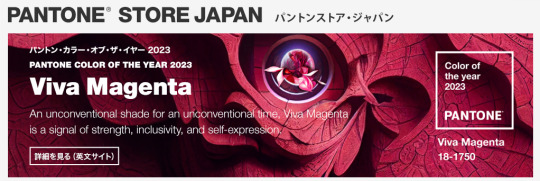
Saguaro’s color palette does actually show off how trendy he is. Many fashion designers reference Pantone color reports in their designs, and vice versa. Color of the Year/or season is determined by fashion runways, trends, and social media. In 2022, the color of the year was Very Peri. In 2023, it was Viva Magenta. Looking back at Saguaro’s palette, doesn’t it seem awfully coincidental that he wears similar colors? Now, SV was released in November 2022. But as I mentioned earlier, Pantone chooses colors based of fashion trends. If Saguaro is as fashion forward as I think he is (which he canonically is considered to be) I wouldn’t be surprised if he caught onto certain colors early. That’s part of what makes certain people seem fashionable or trendy. And because of the timelessness of the deep red of his pants, and the vintage colors of his blouse, he can honestly be trendy most of the time because these colors never go out of fashion.

Something I noticed when looking at all the teachers is that Saguaro and Miriam are the only ones who have silver details- all the other teachers (except Hassel, Jacq, and Clavell, which have no details. This is purposeful but I’ll save it for another post. Altho Hass DOES have golden eyes...) have golden details. I don’t know if it’s a coincidence, but my theory is that Saguaro and Miriam are both struggling with who they are. Miriam was giving up her dream to be a teacher, Saguaro is battling insecurities- I think it’s significant that they both wear silver. The other teacher have their own struggles too, of course, but it feels like Saguaro and Miriam are battling with who they fundamentally are as a person. Their identities are unknown to themselves, and this is marked with silver.

Overall, I think Saguaro’s fashion is a deliberate balance between “casual and approachable” and “respectable authoritative figure.” It’s also the blend of traditionally masculine and feminine fashion, with the suspenders & loafers vs aprons & bows. It’s such an insane balancing act that seems obvious in hindsight, but i never realized until this analysis. Character designer is so underrated. Am I overthinking Saguaro’s design? Yeah, probably. But all designs are made deliberately, and I think it hit the mark with several of my points. He’s a very complicated character, and I love him so much haha \(//∇//)\
#pokemon saguaro#mr saguaro#teacher saguaro#pokemon sv#analysis post#ive had this in my drafts for so long! it was all because of the pictures lol#in case you cant tell#despite how much i love fashion i am terrible at color names#kallistopost
31 notes
·
View notes
Text


Hey there friends- today I finished up my ribbons and checks dress!
It was a weird googling rabbit hole that got me started on this project- I was actually looking for a painting of an Italian Renaissance kirtle, but ended up finding the Peculiar Seamstress's Tartan Caramel Dress and felt inspired to do something a-historical and cozy. I ended up doing a similar silhouette because it was just so sweet on her.
I meant to finish this project in a month, but I often took breaks so I'm not feeling too hard on myself. I only used ~2.5 yards/meters of fabric (it was 60in/152cm wide, 2 full yards/meters and the last was cut to a half width) and I decided to play with this giant spool of ribbon I had!
I spent quite a while draping the bodice pattern and putting together historically constructed 16th century boned sleeves which was a treat. You can see in the first picture that I fully lined the bodice with a beautiful cotton print too. It felt really good to create a garment for the joy of the process and the materials.
The front closure is alternated hook/eye pairs and I think I might need to re-do all of them or pin some kind of stomacher behind them because it keeps breaking open. But overall, I am so pleased!
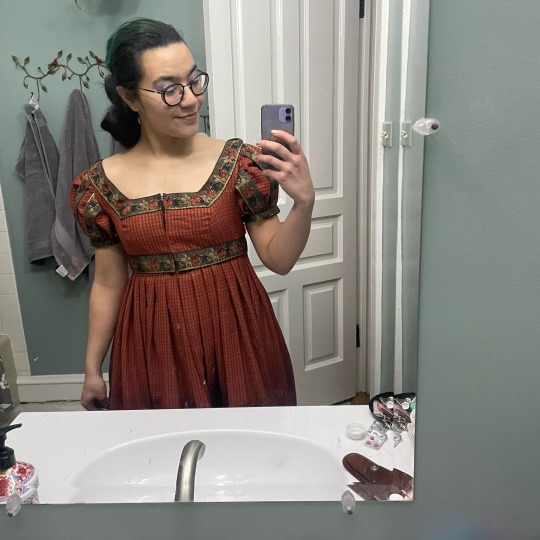
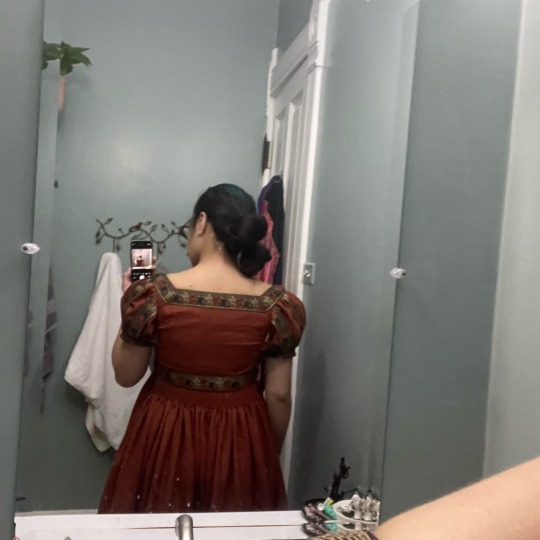
This next project, I am pretty annoyed about, actually. For FIVE years, my grandma has persistently asked me to re-line this jacket for her. For context, she is completely physically capable of doing it herself. She worked as a seamstress for YEARS and taught me to sew, but she doesn't want to re-line it herself and doesn't want to pay someone to re-line it. And I also don't want to re-line it! And she'll say I already agreed to it and I haven't! But she got my aunt to just dump it at my place and she wants to wear it for New Years!


I'm so mad!
And I guess I'm just going to do it because she's like 90!
So I spent about 2.5 hours today carefully taking out the lining. It's going to be a bitch, frankly, to re-line because it's constructed VERY well and in a very frustrating way. So there's the silk outer layer, a layer of wool flannel, and then the shredded silk lining.
Unfortunately, the seams are all done in a super duper traditional Japanese style where the layers are machine stitched together and then tailor tacked so the layers are all offset to have a nice soft fold to each of the edges. I'm not really sure how to explain it more clearly.
But basically every piece is sewn together many more times than they usually are and I cannot rip out the seams because I cannot put it together in a way that will hang as prettily as it does on the body now.

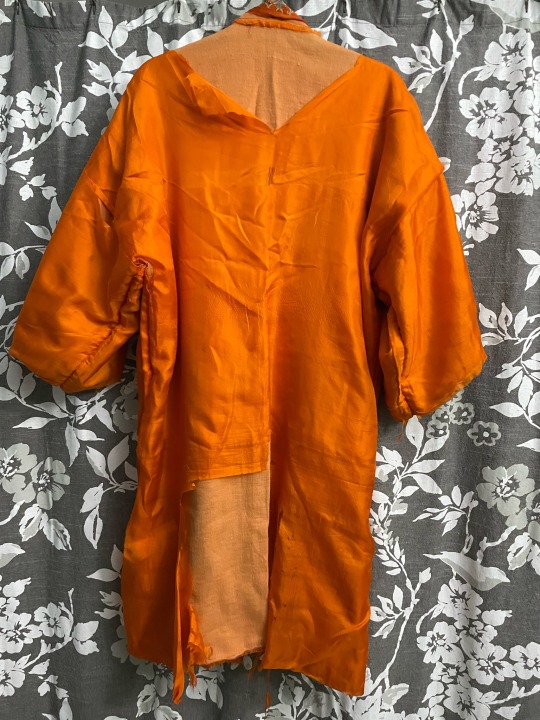
What I need to do is carefully cut the lining fabric where it is sewn down (but not cut the seam), re-create the lining as a bag lining, install the lining at the cuffs/edges like you would normally, and then tack them to the garment at the side seams too.
So far today, I spent 2.5 hours carefully cutting the shredded silk. And then I discovered the fabric she wants it re-lined in is a cheap thick polyester!! Ugh!!!!!!!!
8 notes
·
View notes
Text
I've been kind of kicking around an idea of, like, a semi-guided pattern-using and pattern-making series?
So there'd be several steps, starting from using commercial patterns and going all the way to following and translating patterns like you'd get in Otome no Sewing or Gothic&Lolita Bible. There'd be a bunch of items you'd make, and I'd try really hard to make them be things you can actually use in your lolita wardrobe.
But I'd want it to be really interactive (maybe on Discord? I recently got into Discord) where people can ask questions where they run into problems and get feedback and where everyone can celebrate the heck out of anything anyone finishes.
The route would go vaguely: Learn to follow a basic pattern for a non-clothing thing (bags are nice?) > easy pattern based on body size with minimal alteration (bloomers?) > structured piece with something complex like a zipper or button closure, also choosing commercial patterns specifically for ease of modification (skirts with waistbands and shit?) > blouses with collars and cuffs (because how are you going to follow a pattern for this in a language that you don't speak if you can't follow it in a language you're comfortable with) > we move up to OnS/GLB/old Gosurori patterns that arne't based around body size > measuring a Japanese pattern and adding fullness to change body size > grading a pattern that doesn't fit into a pattern that does > do it all again but in Japanese > and I don't know where this will end but, you get the idea.
I'm an asshole and would not allow you to test out of a level. Since the idea is both to learn and to make things, if you can already make a complex blouse then you can make a bag.

Also this would let us make sure everyone is on the same level and let you fancy people who have already made historically accurate lobstertail bustle dresses and worn them for over 16 straight hours flex and make Usakumya rucksacks when the rest of us are making grocery bags.
Also, because I'm me, I will be offering awards for every single piece completed. Each piece will get an award and the award names and significance will be made up by me on the spot and may make no sense.
Anyway, just a crazy little idea; everyone tell me how that'd sound? Maybe i'm too specific at this point but I've been turning this around for a few days.
Also I wanted to use that gif.
53 notes
·
View notes
Note
hi buriko! I had a question about haori sizing. were haori of the taisho period standardized in size across gender/age group, or were they custom-made, or were they all one size? asking because I'm curious how giyuu was able to continue to wear the haori of his sister and sabito into adulthood. would tsutako and sabito's haori have been different sizes? did giyuu have to refashion each child-size haori into adult-size halves? would he have been at risk of outgrowing them? thank you :)
I'm afraid I don't have quick answers on haori sizes, and "haori" have come from so many other previous historical garments that it's hard to say what's standard! Even today, there are different kinds of kimono overcoats for women, and for men, haori nowadays feel like they are more formal than fashionable.
As a very quick rundown, overcoats like haori (and their predecessors) were only worn by men until the later Meiji period, and when women started wearing them (especially in the Taisho Period), it was especially fashionable to wear long haori. Therefore, lengthwise, I don't think this would had presented any issues. There was indeed a difference between men's and women's haori (and women enjoyed much, much more flamboyant patterns and colors as the period went on), and while I don't know how often they'd have been custom-made with rolls of fabric for sale as opposed to bought ready (you find both patterns nowadays), especially in rural versus fashionable urban places, many garments could be adjusted enough that they could be passed down through generations and still worn by people of somewhat different sizes.
However, the arm width might not had left Giyuu with much room to grow into, especially if meant for a woman's smaller frame (and although the manga doesn't show this, iirc, the Ufotable snapshot of Tsutako had her wearing it like a kimono with hakama instead of as a haori, so it would have been a different cut and fit in the first place). To cover such a generous amount of Giyuu's arm while still retaining the integrity of the original garment fitting together panels of fabric of finite width, I think he might have realistically had to at least replace the sleeves. Under the physical demands of demon slaying, it's probably suffered a lot of damage anyway.
While it's more meaningful to operate under the assumption that it's been the same fabric the whole time which his sister wore, the other reason I find it likely that Giyuu would have replaced pieces of his haori is because we don't know how, or even if he was able to attain Sabito's original. In his flashback in volume 15, we see Murata and one other boy telling him what happened when Giyuu wakes up covered in bandages, but they do not have Sabito's garments. If someone did manage to attain them and deliver them to Giyuu later, there's no telling how damaged they would have been. Perhaps he only used one half of it because the other half was salvageable (in comparison, as Tsutako was killed at night, she might have been wearing bed clothes instead).
I'm also comfortable with Giyuu retaining their memory but always being fastidious in choosing fabrics that are the same as Tsutako and Sabito's tastes, however hard it might be to always replicate perfectly, as he might not had wanted to damage their haori in the first place by cutting them in half. By now the Kakushi probably have his back on this and keep extras of that tortoiseshell pattern in storage.
But on that note, the Kakushi are probably really good at making size adjustments to haori of sentimental value to many of the Corp members. If Nezuko was able to repair, resize, and dye a few haori while waiting for comatose Corp members to wake up, then I think the Kakushi have streamlined the process of basic resizing and mending tears.
That all being said, I'm even worse at sewing than I am at cooking, and you probably shouldn't go to me for expertise in these subjects. It's all in Japanese, but this site has some nice graphics showing how different pieces of haori fit together, and differences between men's and women's (modern) haori. The main takeaway is how horizontal strips of fabric fit together at specific seems of the garment, and how hard it make be to add width because of that.
As a final point of consideration: as much as retro Taisho styles are coveted as antique kimono items, for the most part, the average height of the Taisho population was a lot shorter than it is now, so not everyone is lucky enough to fit into Taisho styles (it's hard to find cheap pre-made modern kimono long enough to fit my arm span as it is; I will never been lucky enough to fit fun Taisho kimono without my wrists sticking way out, which makes me sad). That said, the KnY characters err more on the side of modern heights; in the Taisho era most of them would have been considered very, very, very tall, even the Kamaboko boys.
Sorry this was kind of all over the place! I am sewing-dumb but like kimono from a fashion standpoint.
26 notes
·
View notes
Note
And here's Terrence's!
Character Chart
Character’s full name: Terrence Afton
Character’s nickname: Terry, Mr Grumpy (by Michael, teasing), Shadow Michael (his former name)
Birth date: June 21st (he was a part of Michael, but they decided to share their birth date)
Nationality: British-Mexican
Weapons: gun.
Powers: shadow manipulation, teleportation, can float, invisibility when in a dark environment
Physical appearance
Age: ???
How old does he appear: 22
Weight: 77.6 Kg
Height: 6’3’’
Body build: tall but well built
Eye color: pale red with dark gray speckles
Glasses or contacts: none
Skin tone: almond
Distinguishing marks: black patches that look like vitiligo, faint freckles, scars on his left eye and lip
Hair color: brown fading to dark gray
Type of hair: curly
Hairstyle: short half-ponytail
Usual fashion of dress: punk
Favorite outfit: dark red tank top, ripped jeans, sneakers or tall boots
Jewelry or accessories: belt, long golden earrings, necklace, bandages on the hands
Personality
Alignment: chaotic good
Good personality traits: brave, calm, kind
Bad personality traits: untidy, has a bit of anger issues, solitary, too headstrong
Mood character is most often in: either very calm or angry
Sense of humor: dark humor, very sarcastic and ironic
What single event would most throw this character’s life into complete turmoil: being useless, his twin being in danger
Character is most at ease when: when he's with Michael
Most ill at ease when: around William
Enraged when: somebody he loves is in danger
Depressed or sad when: when he compares himself to Michael
Priorities: help Michael
Character’s soft spot: kids
Is this soft spot obvious to others: no
Greatest strength: sewing
Greatest vulnerability or weakness: Michael
Biggest regret: none for now
Minor regret: none for now
Biggest accomplishment: helping Michael
Minor accomplishment: none
Character’s darkest secret: his collection of romance books
Does anyone else know: only Michael
Past
Hometown: none
Type of childhood: none
Pets: none
Childhood hero: none
Dream job: none
Education: none
Religion: none
Finances: none
Present
Current location: Spirit Limbo
Currently living with: all the Souls that had became William's victims
Pets: white snake named Urobos
Religion: none
Occupation: none
Finances: none
Family
Adoptive mother: Daniela
Relationship with her: very good
Adoptive mother: Claire
Relationship with her: neutral
Father: none
Relationship with him: none
Adoptive father: Henry
Relationship with him: normal
Sister: Elizabeth
Relationship with her: normal
Brother: Evan
Relationship with them: normal
Adoptive sister: Charlie
Relationship with them: normal
“Twin”: Michael
Relationship with them: extremely good
Spouse: none
Relationship with him: none
Children: none
Relationship with them: none
Other important family members: Cassie and Gregory (nephews), but has friends (the former Tormentors)
Favorites
Color: red, black, gray
Least favorite color: pink and green
Music: classical
Food: japanese cuisine
Literature: romance and historical
Form of entertainment: watching soap operas
Mode of transportation: teleportation
Most prized possession: a necklace gifted to him by Michael, his gun
Habits
Hobbies: sewing
Plays a musical instrument: no
Plays a sport: no
How he would spend a rainy day: watching soap operas or designing and sewing clothes
Smokes: a bit
Drinks: no
Other drugs: none
What does he do too much of: argue
What does he do too little of: none
Extremely skilled at: sewing and programming
Extremely unskilled at: drawing
Nervous tics: smoking
Usual body posture: good
Traits
Optimist or pessimist: realist
Introvert or extrovert: Introvert
Daredevil or cautious: cautious
Logical or emotional: logical
Disorderly and messy or methodical and neat: messy
Prefers working or relaxing: work
Confident or unsure of himself: a bit unsure and self-conscious
Animal lover: yes
Self-perception
How he feels about himself: sees himself as just another version of Michael
One word the character would use to describe self: a glorified copy
What would the character most like to change about himself: doesn’t know
Relationships with others
Opinion of other people in general: neutral
Does the character hide his true opinions and emotions from others: no
Person character most hates: William
Best friend(s): Mark, Simon, Fredrick
Love interest(s): none
Person character goes to for advice: OMC
Person character feels responsible for or takes care of: Michael
Person character feels shy or awkward around: Michael’s family and friends
Person character openly admires: none
Person character secretly admires: Michael, Charlie and OMC
♪Lullaby_⁜_Anon♪
Interesting.
6 notes
·
View notes
Note
blorbo blursday! have you ever thought about a miniature roses modern au, and what might be different for minnie and ruzena if their story took place in good ol 2023?
Yes, I've thought about this a lot! Miniature Roses was conceptualized as a historical fantasy for a very particular reason. I needed long-term blood storage in large amounts to be just outside the realm of technological possibility in order to present Minnie and Ruzena with the challenges they need to drive the plot. So the story would actually look so much different!
However, I love to think about what the two of them would think of the modern world (and, thanks to vampiric immortality, this could even be canon if Minnie ever joined Ruzena as a vampire). Here's some thoughts:
Ruzena would love to see another hundred years of fashion history evolve. I think she'd be fascinated especially by any subculture inspired by historical wear (Japanese lolita fashion, for example). I think she'd love to sew for historical reenactment, and her work would obviously be unparalleled in accuracy. She would be very hardcore about it and actually revert to old methods of construction.
Even I cannot fathom the depths of Minnie's excitement to see a hundred years of science history unfold. Imagine her seeing the polio vaccine, the development of quantum physics, the moon landing (she and Ruzena both would watch that with bated breath), the sequencing of the human genome, better and better imaging techniques for unlocking the mysteries of the human body, and so much more. Minnie would absolutely still be working in the sciences, but what field she ends up in could be anyone's guess!
6 notes
·
View notes
Photo

On November the 4th 1966, the river Arno flooded into Florence burying hundreds of thousands of books, manuscripts and artwork beneath mud, debris and putrid water. Due to this massive cultural and historical devastation, countries responded quickly with financial aid and restoration research. It became imperative to combine modern science with historical book making techniques in order to save and restore the damaged antiquarian books and manuscripts. Experimental research was used from The Institute of Book Pathology in Rome, and The Imperial College of Science and Technology in association with The Royal College of Art in London.
Damaged books were given emergency washing and drying treatments and then sterilised against bacteria and mould. The edges of a lot of books were badly stuck with mud, gelatine and sawdust. The covers/boards, spines, headbands and everything surrounding the text block were removed and catalogued in envelopes. Once the spine was clear the sewing was cut from the spines and the sections separated carefully. Mud was scraped from the leaves of the book, and especially bad books were soaked in an alcohol and water mixture and then interwoven with wet strength paper and washed again. Coloured plates and prints were sprayed with a solution of soluble nylon in alcohol to preserve them. Any oil that may have damaged the books was removed with a solution of xylene and trichloroethylene. Fuller’s Earth was applied delicately and brushed off to remove excess chemical solution and oil.
Thermostatically controlled, stainless steel, sinks were used to wash the books leaf by leaf in a fungicide solution. Some particularly fragile leaves were resized. pH tests were conducted and if a book had too much acidity, it was deacidified. Bleach staining is not considered good practice, and was limited to the leaves that were so stained that the text was illegible. The individual leaves were dried at controlled temperatures in specially made drying cabinets. Once dry, the leaves were checked and put in order. (Plates and prints were handled separately to the main text blocks as extra care had to be taken due to the colours.)
Before sewing and binding could take place, repairs were made to the leaves caused by the flood and early binding techniques. Lens tissue was used for small tears, and Japanese tissue paper was used for serious tears and missing sections of leaves.
Books were sewn back together with thread and techniques dependent on their size and publication date. Appropriate bindings were also chosen depending on the use of the book and its time period. The majority of the damaged Antonio Magliabechi manuscripts and volumes from the National Library of Florence were bound in limp vellum. Other rare books required new leather bindings.
The restoration of books, manuscripts, art and historical artefacts from the 1966 flood is still an ongoing process today. Many people had to be trained specially to restore books on site in Florence, as shipping damaged books to experts across the world was deemed to be impractical and quality could not be controlled. There was also the risk that the books would be lost or damaged further in transit.
Floods and natural disasters cause widespread damage but are fortunately not that common. Some books are damaged over time due to use and age. Working in a second-hand bookshop, I see a lot of old books that are damaged; missing spines and boards, detached boards, bumped corners, missing labels and stained. Modern books are notoriously poor quality and tend to fall apart easily in comparison to their sewn, medieval ancestors. There is a genuine calling for restoration and book binding experts. Some old books are scarce, and some books have signatures or notes in their margins from historically important people which make them unique and irreplaceable. For the individual, books passed down through the generations hold significant sentimental value and may need repairs or complete new bindings. If history teaches us anything, it is that we need to continue to find methods and solutions to protect and save items of historical importance.
References:
The Restoration of Books: Florence – 1968. – YouTube
The Disaster that Deluged Florence’s Cultural Treasures – HISTORY
The great flood of Florence, 50 years on | Art and design | The Guardian
https://blog.outletpublishinggroup.com/2023/02/23/blog-156-the-importance-of-book-restoration/
3 notes
·
View notes
Text

Decided to work a little on him and return now!!
Yasusada was born to a traditional family in Kyoto and was trained in sword fighting, archery, and horseback riding by his family. While he is rather skilled in those things, Yasusada never would have done it seriously, making his time in the Sengoku period very overwhelming.
Unlike Canon!MC, I can see Yasusada being a student of economics or something like that. Idk I'll try to put more thought into it, I'm not sure but I'm open to suggestions.
He'd somewhat have some historical knowledge - albeit it'd be not much and somewhat romanticized - He'd enjoy watching Jidai-Geki series and reading mangá related to it.
Yasusada would take up sewing as a hobby and slowly learn it through the game. I like to imagine he'd learn from a maid he became friends with.
Yasusada's hair color is a very light brown that almost looks somewhat blonde, but he'd dye his hair. His hair color would return to the color it once was throughout the story.
Yasusada has a bad relationship with his family, he would be seen as a disappointment by them and would become used to leaving Kyoto for weeks and would start to mostly live in Tokyo.
He would understand and speak english to some degree. However, due to Yasusada's japanese heritage and being raised in a very traditional environment, he would not be fluent in it.
Yasusada is gay and that would lead to a lot of fighting between him and his family, causing him to have little to no contact with them. He would rather have it that way.
He was part of the archery club in his school and due to this, he does have great aim and knows his way with a bow and arrow.
#ikemen sengoku headcanons#ikemen sengoku headcannons#ikemen sengoku hcs#ikesen headcannons#oc headcannons#ikesen oc headcannons#ikemen sengoku oc#ikemen series ocs#ikemen sengoku#❪🌸❫ Achilles writes#❪🌸❫ Achilles Rambles#❪🌸❫ OCs
8 notes
·
View notes
Note
Hi! Tumblr won't let me answer your question, for some reason, but I'd love to gush about sewing machines to you! Is there anything specific you want to know? I'm mostly interested in antique sewing machines, from a material history perspective - you know, retracing the history of people by looking at objects :)
That’s very strange—I’ve been having a lot of trouble with asks on tumblr lately ¯\_(ツ)_/¯
I love retracing the history of people by looking at objects! I’ve been getting deeper into costuming and cosplay lately. I’m particularly interested in recreating a character’s look as accurately as possible by trying to figure out what they’re actually wearing as opposed to what it looks like they’re wearing (if that makes any sense). I’ve been learning a lot about Japanese traditional garments because I’m mostly doing anime characters lol. But I also love western historical fashion, especially anything involving corsets and petticoats.
I’d be really interested to hear how the sewing machine changed fashion and the culture around clothes when it first came into use, if that’s something you’re interested in. But really anything about sewing machines and fashion history in any part of the world interests me.
0 notes
Text
Pintô Art Museum
Tucked away in the lush hills of Antipolo, just a stone's throw from the bustling heart of Manila, lies a hidden gem that's every art lover's dream – the Pintô Art Museum.
Whether you're into vibrant paintings, thought-provoking installations, or sculptures that seem to whisper stories, this museum has it all. It is a place where Filipino artists, both renowned and up-and-coming, showcase their talents through creative expression.

As the name of the museum suggests, “Pintô” which means door, could represent how art plays a role in bridging distinctive nationalities, worldviews, and communities. When I stepped through those doors, it was as if I had wandered into another land as I was greeted by a lush scenery of greenery with different art pieces scattered around, seamlessly merging with the natural landscape.
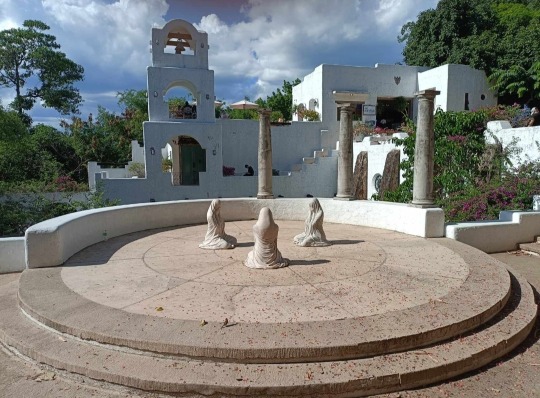
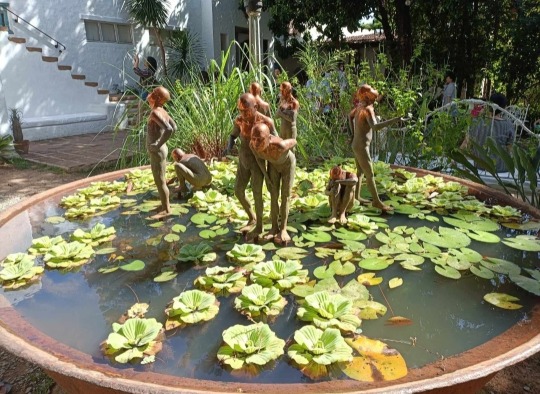
The outdoor area of the museum is a sensory wonderland, where every twist and turn in the garden paths reveals a new visual delight. Unfortunately, this also meant that most of the outdoor pieces did not have a visible title or description for me to view. Nonetheless, the pieces displayed were a breathtaking sight and these pictures just do not do them justice. These grand art pieces are a must-see in person!

I enjoyed being surrounded by both nature and art however, as the heat of the sun shone brightly, it was time for me and my family to head inside the many buildings to view the different exhibits and paintings.

While browsing, I found not one, but two of John Paul Duray’s works - “Tomato” which is a tomato pin cushion turned chair that was inspired by his mother and grandmother who sewed clothes (which I could say is almost a universal experience shared amongst us Filipinos), and “Bono” the banana man that is sitting on the tomato which was one of the sculptures featured in his very first solo exhibition “You Are/Pagkatao”.

Me and my sister sat in front of part of the “Karnabal” by Salingpusa group. In 1992, the group finalized it and it served as a landmark piece in the realm of contemporary Filipino art. From the Pinto art website, “This artwork serves as a metaphor, portraying Philippine society as a dynamic carnival where various forces and players contend, offering a poignant representation of the societal conflicts that emerged in the aftermath of the People Power Revolution.” The acquisition of artworks as support for the development of this group became the catalyst for the growth of the museum’s art collection.

Salingpusa sub-group Sanggaw created the piece "Kasal sa Hatinggabi" ("Wedding at Midnight: The Church and the State"). It shows a gun and a knife in the hands of the politician and the priest hugging each other unified under a church bell. Does this unity symbolize their enaction of violence together? Or is the piece alluding to their actions in secret as their alliance would violate the separation of the church and state?

Riel Hilario is an artist who aims to “…make sculptures that seem to exist on their own will.” In the piece “Even Monkeys Fall Out of Trees” the name of the piece originates from a Japanese proverb, 猿も木から落ちる (saru mo ki kara ochiru) which reminds us that even experts make mistakes. I cannot shake the feeling of the woman with her monkey with a nearly vacant, indeterminate gaze offering such a domineering presence.

Joven Mansit’s “Carcass (Pietà)” piqued my interest in the realm of gore, blood, and body. To “salvage” something is to save something yet in the Philippine language, it means to “kill” or “murder”. I found that the parody of this historical image (a pietà), which should offer the viewer nostalgia, is negated by the presence of a large carcass as a conflicting existence that doesn't seem to relate to the underlying image, except as a way to rescue the picture in a harmful way.
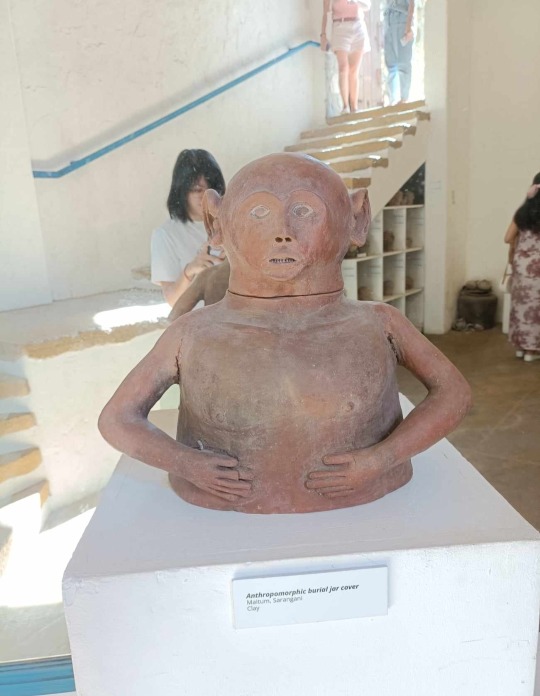
Amidst the Filipino contemporary art lay many early Filipino cultural artifacts as well such as one of the Maitum anthropomorphic burial jar lids which served as secondary burial vessels. The anthropomorphization of burial jars was only seen in the Philippines many of which had a range of expressions and female lids were also discovered suggesting an equality in terms of the practice of jar burials for early Filipinos.
1 note
·
View note
Text










Studio Project #1: Awesome/Terrible Banners!
Our first studio project starts with a site: the fiber studio ceiling above our heads. This is the place where our studio project will be installed as a collaborative installation of individual artworks incorporating each of our individual artistic voices into a collective installation experience.
Inspired by the complexity of translations in a fiber reference from the Bible in Song of Soloman (Song of Solomon 6:10) and the plethora of flag based artwork about identity and culture in recent years by contemporary artists, as a class, we will be creating an installation experience with each of us contributing a flag/banner like work that hangs from the ceiling in the center of our fiber studio space. The challenge for each of us is to create an individual object that works in chorus with other artworks to create a unified installation experience.
What do you want to say in your work? How does your individual artistic voice hope to contribute to the conversations happening in art?
Here are the studio project #1 rules:
1.) You can choose what fabrics (cellulose, protein or synthetic or a combination of these) you use for this project. Your ideas should be the drivers of your material choices.
2.) The fabrics you use for your flag/banner should be primarily dyed and designed by you. You can use any of techniques we have covered and will cover in this class so far. This is not a project about using commercially sourced fabric.*
3.) Your project can include a composition of patched fabrics or can be a single piece of fabric. Use your sewing knowledge to patch together a larger piece of fabric from smaller parts. You can use the sewing machine, hand sew, or a combination of both.
4.) This is a mixed media friendly project. You are encouraged to use surface embellishments in your projects, things like embroidery, beading, sequins, etc. You can also include skills and materials you already have from outside of fiber into your fabric designs (such as photography, design, painting, etc.). Your ideas should be the drivers of your material choices.
5.) Your banner/flag will have 2 sides: one that faces the door of the studio and one that faces the back wall of the studio. Your concept should consider and utilize both sides of your fabrics surface toward meaningful ends.
6.) Your banner/flag should be about some of the ideas of current interest to your work at large. It should serve articulate your own point of view as an artist. Your flag represents you in the larger structure of the installation environment, much like an American flag functions in an international context.
Deadline: Thursday, October 19th. Your project should be installed and ready to discuss together by the beginning of class.
Images above from top:
woven flag project by artist Sonja Clark called “Monumental Cloth: The flag we should all know”
both sides of one of the banners included from the larger installation called “In the Wake” project by Cauleen Smith for the 2017 Whitney Biennial
artwork by Kimsooja
film still from 1960s Japanese film “Samuri Banners”
an image of the women’s March in Washington DC in 2016
an image of one of artist/educator Corita Kent’s annual Mary’s Day parades from the 1960s
historic photo of suffragette protest with banners
an example of a suffragette banner preserved by the Oklahoma Federation of Colored Womens Clubs Collection of the Smithsonian National Museum of African American History and Culture
one major inspiration for our project: the fiber studio site
another inspiration: the complexity of translating this biblical fiber reference
0 notes